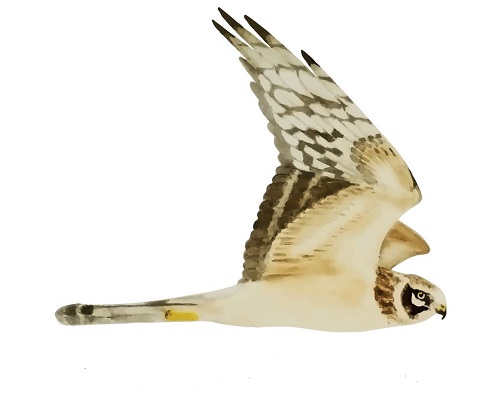Her på Skagen Fuglestations blog bringes korte nyheder i dagbogsformat om hændelser på fuglestationen.
Se indlæg fra måned: jan. (2)feb. (3)mar. (31)apr. (30)maj (31)juni (30)juli (31)aug. (31)sept. (30)okt. (31)nov. (30)dec. (9)
Red Throated Diver Rushhh
This Autumn has flown by and now today is already the penultimate day of our standard observation season! The weather for tomorrow looks quite rainy meaning today might be the last day of standard migration count this year, so all seven of us bundled up in our many layers, packed plenty of snacks and headed out to World’s End 3, where the sunrise was beautiful once again. After a very quiet last few days, our expectations were quite low, except for János who had predicted a big migration day during dinner last night, and he turned out to be right!

I was counting migrating Kittiwakes (Ride) today and in the first hour they were already passing by in their hundreds! But the most surprising and spectacular observation from today was the 394 Red-Throated Divers (Rodstrubet Lom). In the first couple of hours, we were seeing a steady trickle of divers but then suddenly there was a huge influx, with a constant stream of birds, some flying one behind each other, some in big groups. In only 10 minutes we counted over 250 migrating northwest past the tip at Grenen, along with one larger diver (Lom) which could either be a Great Northern Diver (Islom) or a White-billed Diver (Hvidnæbbet Lom), but we’re not completely sure this time; either way it’s exciting to see these big and beautiful birds!

A personal highlight for many of us was when Florian suddenly shouted out at the top of his voice: “Cranes”! In seconds, we had all turned around to see three majestic Common Cranes (Trane) flying right over our observation point! These are the first Cranes that any of us have seen in Skagen and are particularly significant for Florian because they are the 200th species he’s seen or heard in Denmark!
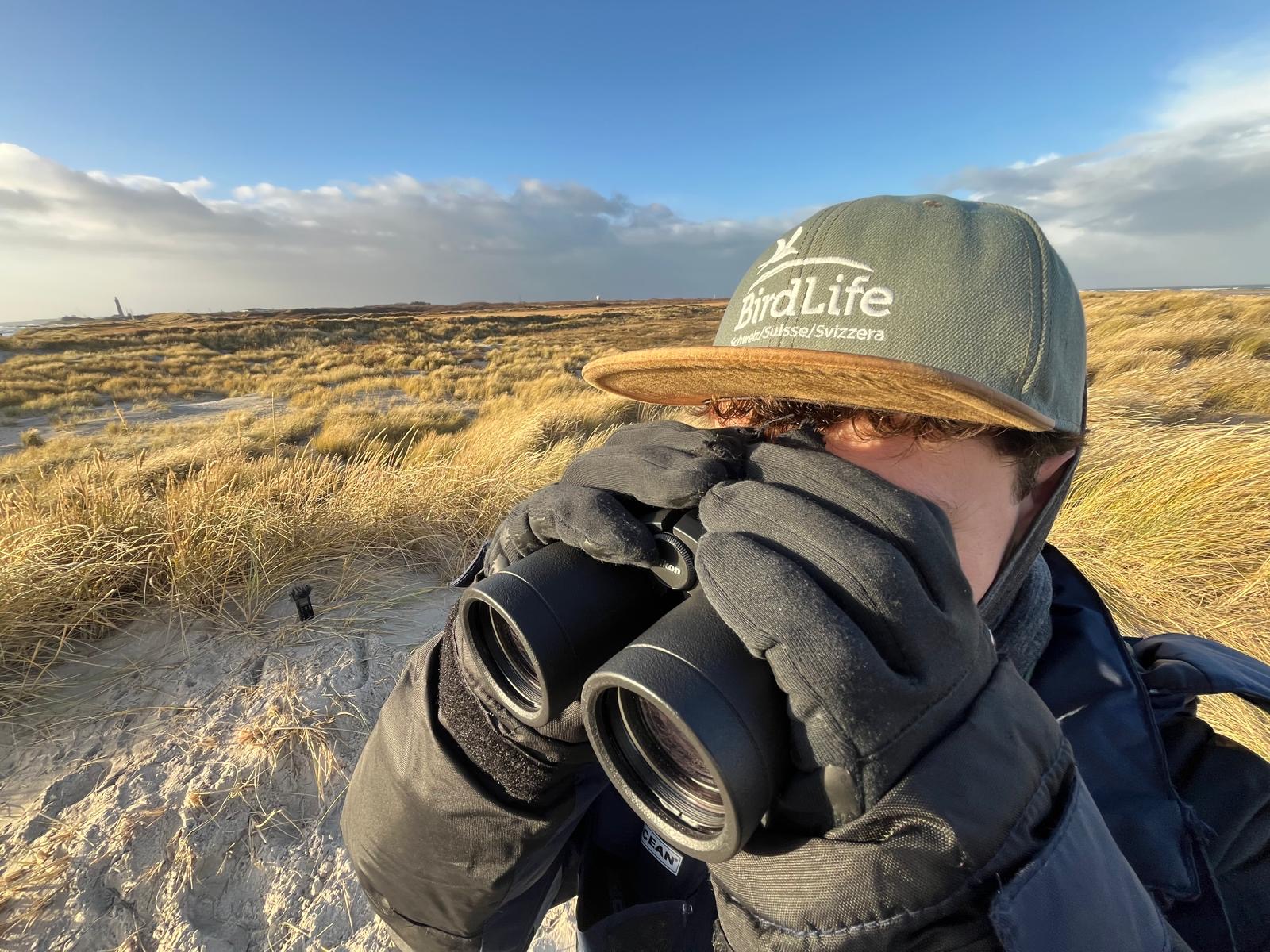
Another highlight was two Little Gulls (Dværgmåge) which we haven’t seen in quite some time now, but are always a lovely treat. Another surprise visitor to the migration count was a very lonely and sad looking Razorbill which was perched at the base of a sand dune when we arrived at World’s End 3 at sunrise. Over the next hour we watched it hop, flap and attempt to climb up the small sand dunes near us but without much success, until finally it disappeared and we hope flew away happily!

Just half an hour before the end of our standard 4hrs of counting, the heavens opened and it began to rain heavily. We checked the weather radar, and it showed continuous rain for the next few hours, so we decided to pack up and head home rather than getting super soggy and cold. In the afternoon, János, Miles and I did some office work, and later I went for a walk and spotted a Hen Harrier (Blå Kærhøg), Rough-legged Buzzard (Fjeldvåge), and a Common Buzzard (Musvåge), a nice trio of raptors.
Florian travelled to Frederikshavn for some birdwatching and was excited to see the first Egyptian Goose (Nilgås) for the town since 2022! His mission was to spot three species which he had not seen in Denmark so far: Kentish plover (Hvidbrystet Præstekrave), Greater Scaup (Bjergand), and Little Egret (Silkehejre). He almost achieved his goal, seeing both the Kentish Plover and Greater Scaup, but unfortunately failed to spot the Little Egret this time. Nevertheless, he had a brilliant time and saw so many ducks and waders, so a good afternoon of birdwatching.
It has been so lovely to have Lise’ best friends, Kat and Vic, come to stay with us this weekend, and they joined us for this morning’s observations too. After the rain stopped, they went for a nice walk to Jennes Sø and saw many Goldcrests (Fuglekonge) and Fieldfares (Sjagger), and then toured the Skagen supermarkets and did a much-needed big grocery shop for us. Thank you!
Standard ringing season has finished for 2025!
Link to today’s observations from the area
People: Miles Scheuering, János Schadl, Florian Hatt, Amira Nuseibeh, Lise Mastrup, and our guests (Lise’s friends) Kat and Vic.
Warm Air and Warm Sea
Today was surprisingly warm when Lise, Amira, János and I went out to World’s End III. Therefore, I decided not to take the warm boiler suit but to enjoy the warm weather (around 10°C) in my own clothes.
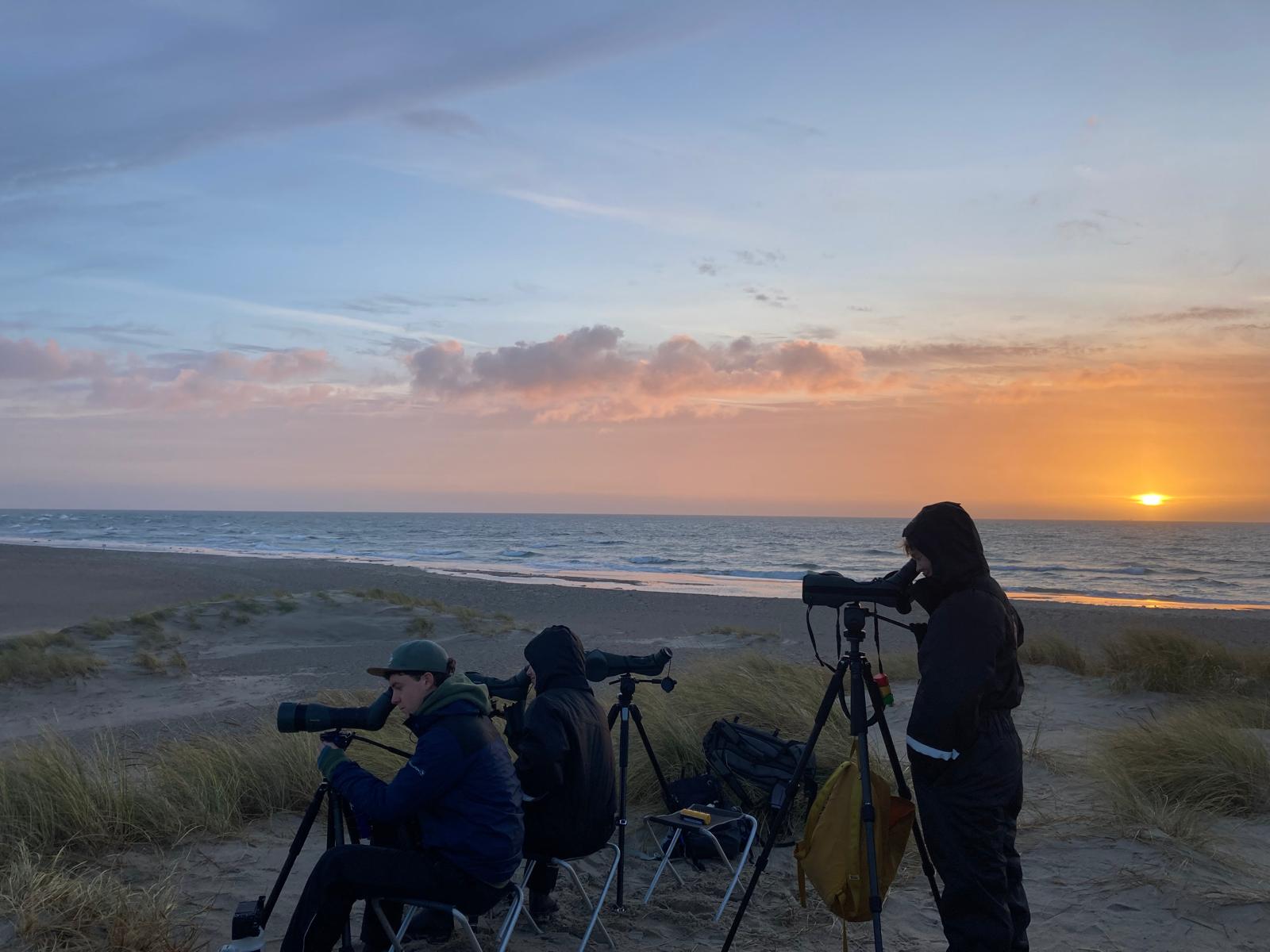
Observers at World's End III
The wind blew strongly from the south-west, which did not really result in many birds. But there were some nice birds resting. For example Black-throated Diver (Sortstrubet Lom) and a small group of Great Crested Grebes (Toppet Lappedykker). When looking inland we got some nice views of a juvenile female Hen Harrier (Blå Kærhøg) and of the pair of Stonechats (Sortstrubet Bynkefugl) that is hanging around in the area for many weeks now. The Kittiwakes (Ride) were a bit more numerous than other species, and some came very close, since a large part of the beach got flooded today. We even had to move our bicycles a little because the water level rose rapidly during the observation period! Also, the tourists couldn't walk all the way to the tip, which meant that some of them came to World's End III instead and talked to us. After the first 2.5 hours Knud went down to the beach, as there wasn't much going on with the alcids (alkefugle) that he was counting as always. Just then, two Brent Geese (Knortegås) flew in and made a few rounds over the beach. Knud was lucky and was standing in the right place, so he was able to take a great photo of them.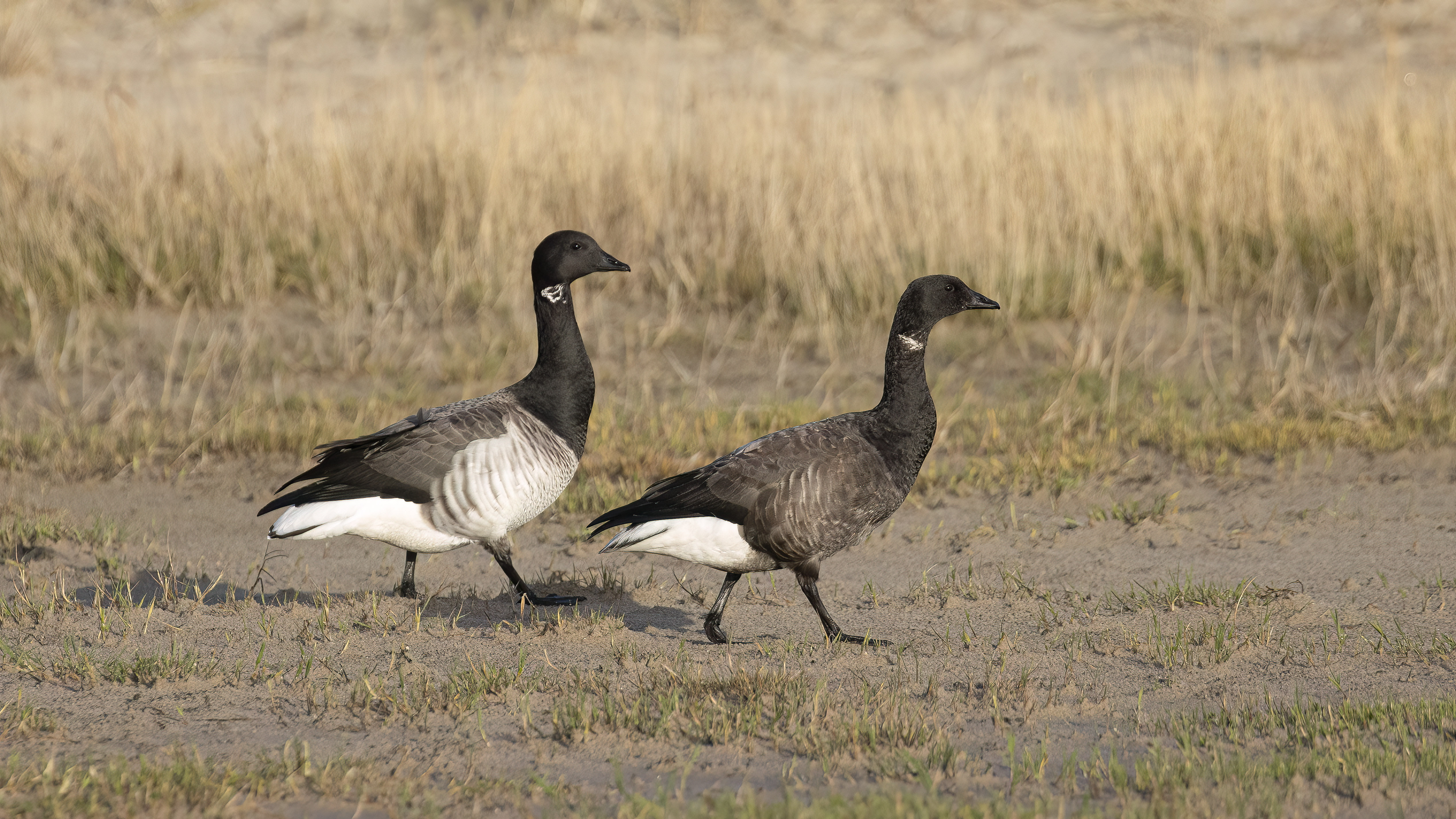
Lysbuget og Mørkbuget Knortegås, Photo by Knud Pedersen
It was really nice to see them so close, and even more fun was the fact that one was of the light-bellied and the other was of the dark-bellied subspecies. After that, I took over counting the auks, which at first was actually very little work, but then surprisingly increased significantly in the last hour.
Afterwards, I stayed outside and walked along the outermost row of dunes towards Nordstrand. I spent some time with a very skulky Reed Bunting (Rørspurv) and unfortunately could never see it properly to rule out a rarity for sure. But I saw two Water Pipits (Bjergpiber) flying around over the reed beds, always nice to hear and see them!
Miles had an office day today and, among other things, recorded a tutorial on how to fold paper Christmas stars correctly. Now we can finally all get started and decorate our little tree with lots of stars! You could watch the tutorial here: https://youtu.be/vi1YSKKjflY?si=6xSqAdUkR8jhkFte
In the afternoon, Miles and Amira went swimming in the sea again. They described it as surprisingly warm! Amira also went for a walk to Guldmajssøen and went upstairs to the lighthouse in the evening. Afterwards, Lise presented her session about her time at Blåvand and Geddser Fuglestation!
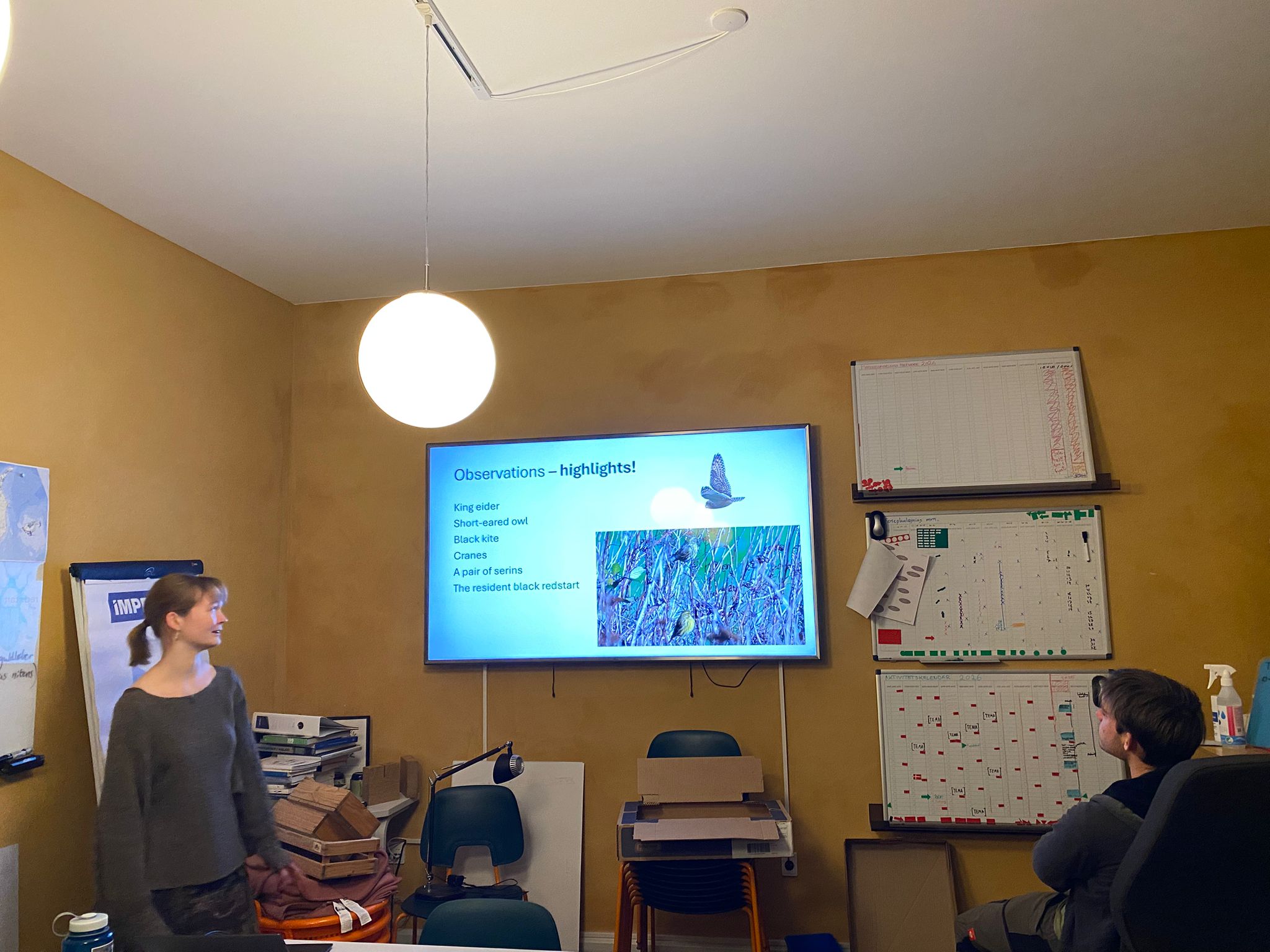
Lise's presentation
It was very interesting to see how the stations differ and which bird species are most common there. Now we're waiting for dinner, which János is preparing. It smells really good already!
Standard ringing finished
Highlights from World's End III
Bjergpiber (Water pipit) 2
Sortstrubet Lom (Black-throated Diver) 2
Lysbuget og Mørkbuget Knortegås (Light- and dark-bellied Brent Geese very close!)
Link to today’s observations from the area.
People: Miles Scheuering, János Schadl, Florian Hatt, Amira Nuseibeh, Lise Mastrup, Simon S. Christiansen
Thanksgiving feast
Today there were strong winds and considerable rain in the morning, meaning the migration count was canceled. This meant there was time for some of us to exercise in the morning, followed by an office day for everyone! Amira woke up early to go to the pool in town for lap swim and then did a little grocery shopping before returning home. We had big plans for our Thanksgiving dinner, so we needed to stock up on a lot of things at the shops. Meanwhile, I went out for a run and ended up going a bit longer than usual, all the way out to Nordstrand, and then along the beach to the tip and back to the lighthouse. It was great to be out, and the strong wind and rain felt quite invigorating! The final stretch back to the lighthouse was maybe a bit too bracing, however.
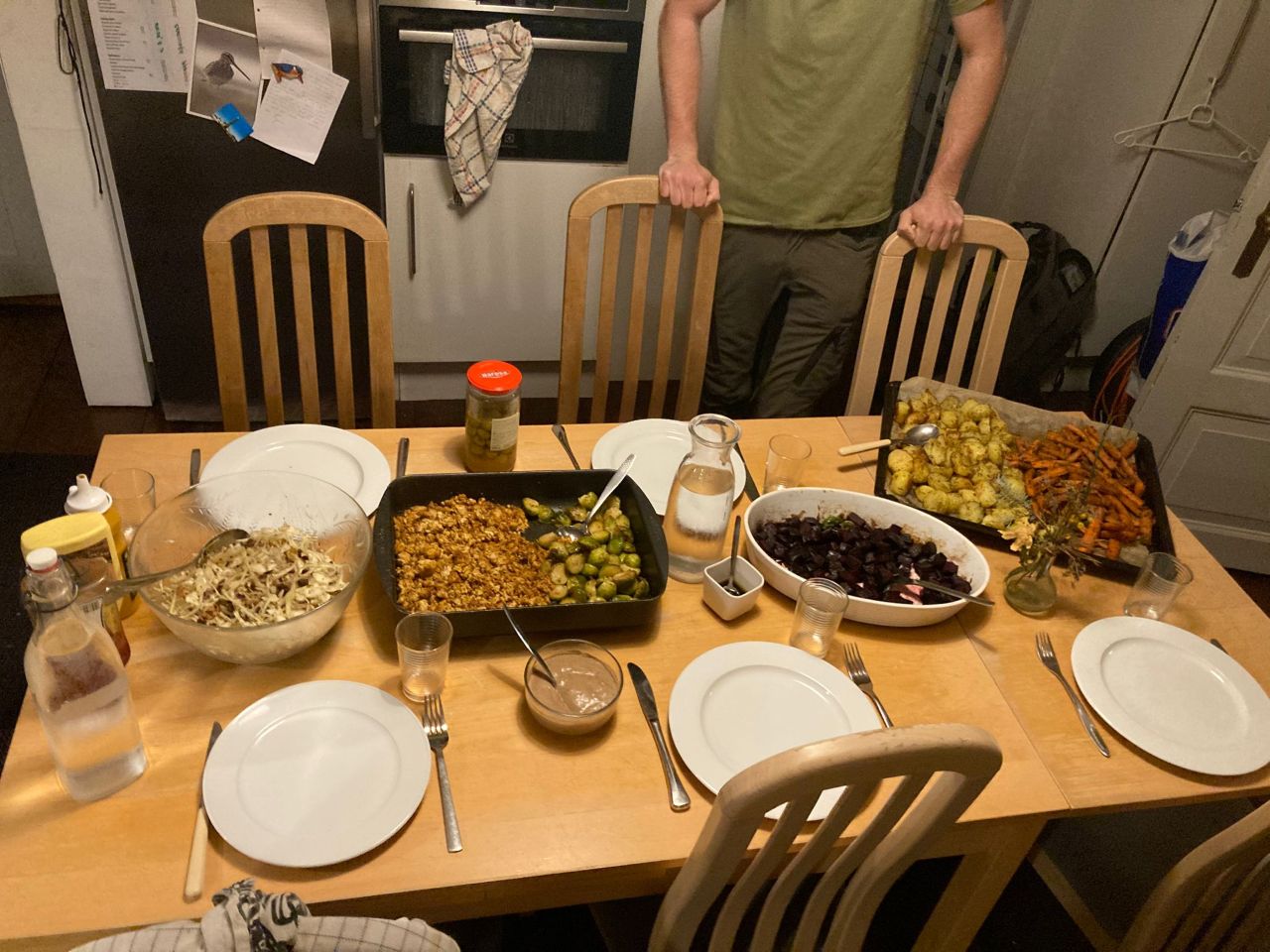
The Thanksgiving spread. From left to right: salad, tofu, roast brussel sprouts, gravy, roast beets, roast potatoes, roast carrots. Photo by Amira
After getting back I roasted a pumpkin, which would eventually turn into pumpkin pie. We reviewed guidelines for the migration count, worked on our sessions, reviewed the picture archive, and later when Simon arrived, helped check ringing data sheets. While not the most exciting day, it was very good to make progress on these tasks. Simon has been at Lille Vildemose the last few days, helping with Taiga Bean-Goose (Sædgås ssp. fabalis) catching for Lisa’s PhD project. He has been their lucky charm this fall, and they have always caught geese when he has been there!
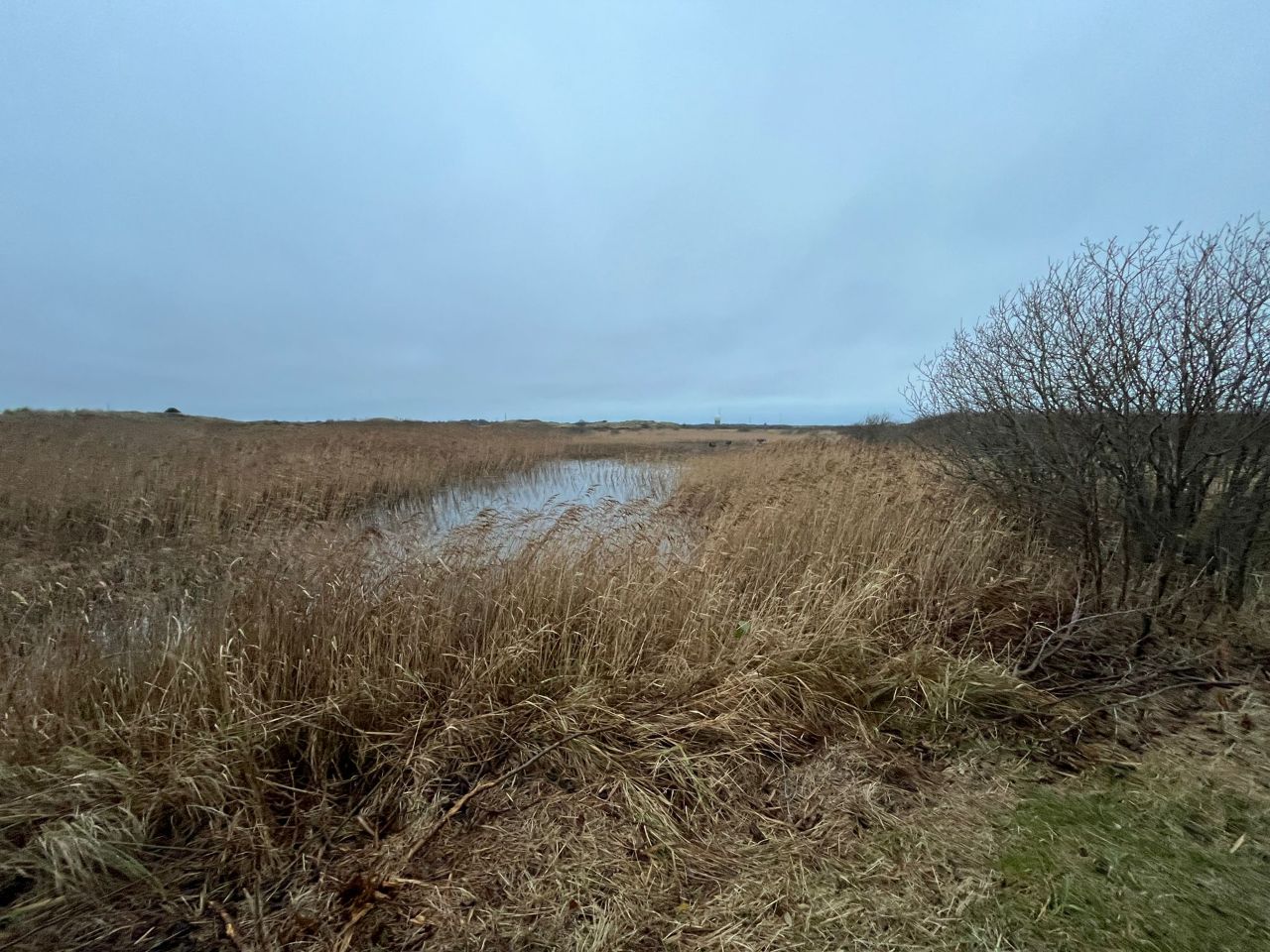
A late afternoon walk out to Ellekrattet, after the rain had abated. Photo by Florian
In the United States, today is Thanksgiving, so in the evening we all worked to prepare a feast. Traditionally, the main course is roast turkey (Kalkun) but we opted for tofu. After evening meeting, I finished making the pumpkin pie, then helped Amira and Lise chopping and preparing roast vegetables. Lise also made a delicious salad and some vegan gravy. Meanwhile, Florian and János provided excellent moral support and kept the playlist well stocked with bangers. We have a lot to be thankful for here at the station this fall. There were many good birds, and the volunteers, guests, and locals have all been fantastic.
Standard ringing finished
No observation today
Link to today’s observations from the area.
People: Miles Scheuering, János Schadl, Florian Hatt, Amira Nuseibeh, Lise Mastrup, Simon S. Christiansen
En holdindsats for fugle og snegle
Amira, Miles, János og Florian tog i dag ud til Verdens Ende 3 til morgenobservation. Muligvis årets sidste fra denne lokalitet, da observationssæsonen slutter på søndag og vejret lover regn og blæst, som det ser ud nu. I dag bød heldigvis på roligt vejr, med kun lidt vind og til gengæld masser af dejlig solskin.
Med hensyn til småfugle blev der set blandt andet to bjergpibere (water pipits), grønsiskener (siskins), snespurve (snow buntings) og rørspurve (reed buntings). Desuden var der mange rastende fugle på stranden, heraf en ung svartbag (greater black-backed gull). De rødstrubede lommer (red throated divers) viste sig også i et pænt antal, på et tidspunkt med 17 fugle der trak i samlet flok. Observatørerne fik dertil to sortstrubede lommer (black throated divers) at se og flere sortænder (scoters) end forventet.
På trods af en relativt langsom morgen kunne de vende tilbage til stationen i godt humør og med en fin artsdiversitet fra dagens morgenobservation. Det gode humør skyldtes uden tvivl også, at Amira havde været så sød at smøre madpakker til hele holdet aftenen før. Dette med stor umage og hensyn til hver af gutternes præferencer for pålæg og brød.
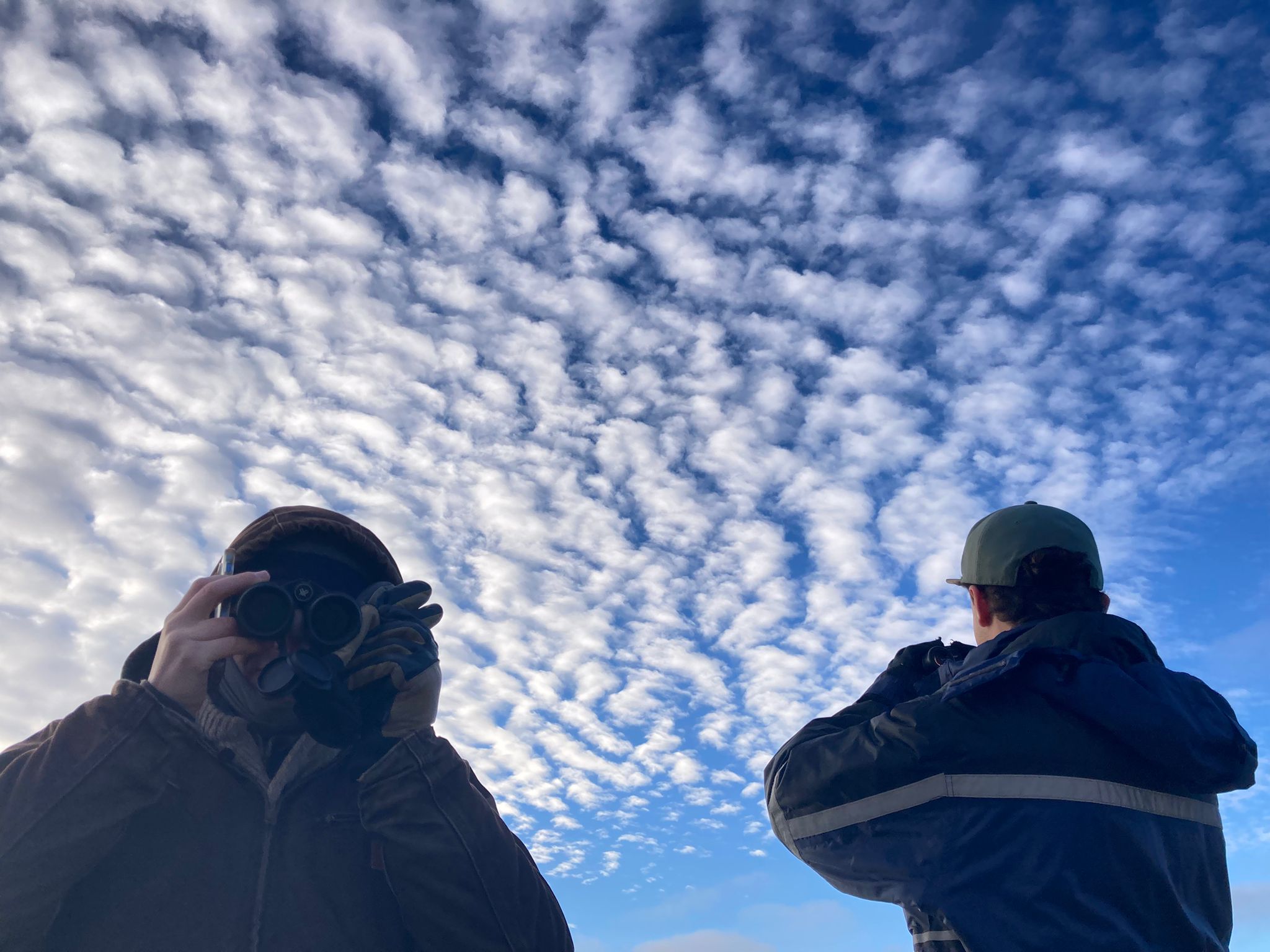 Miles, Florian og himlen fra dagens morgenobservation.
Miles, Florian og himlen fra dagens morgenobservation.
Selv var jeg (Lise) blevet hjemme på stationen for at arbejde på indendørsopgaver. Da observatørerne var hjemvendte og efter en velfortjent frokostpause, var vi alle ude af døren for at trække i vaders og gå sammen ned til høfderne nær fyret. Vi havde en vigtig opgave på programmet i dag, nemlig at indsamle purpursnegle. Disse skal bruges i et forskningsprojekt af Aarhus Universitet om miljøfarlige stoffer i det kystnære miljø. Dette skulle vise sig at være en rigtig hyggelig, sjov og spændende opgave, som vi alle nød at være med til i eftermiddagssolen og inden længe havde vi de snegle, vi skulle bruge. Amira, Florian og Miles blev hængende lidt ved høfderne og gik på opdagelse blandt stenene. Her fandt de både en søstjerne og så to skærpibere (rock pipits).
 Hele holdet fra stationen i vaders og godt humør.
Hele holdet fra stationen i vaders og godt humør.
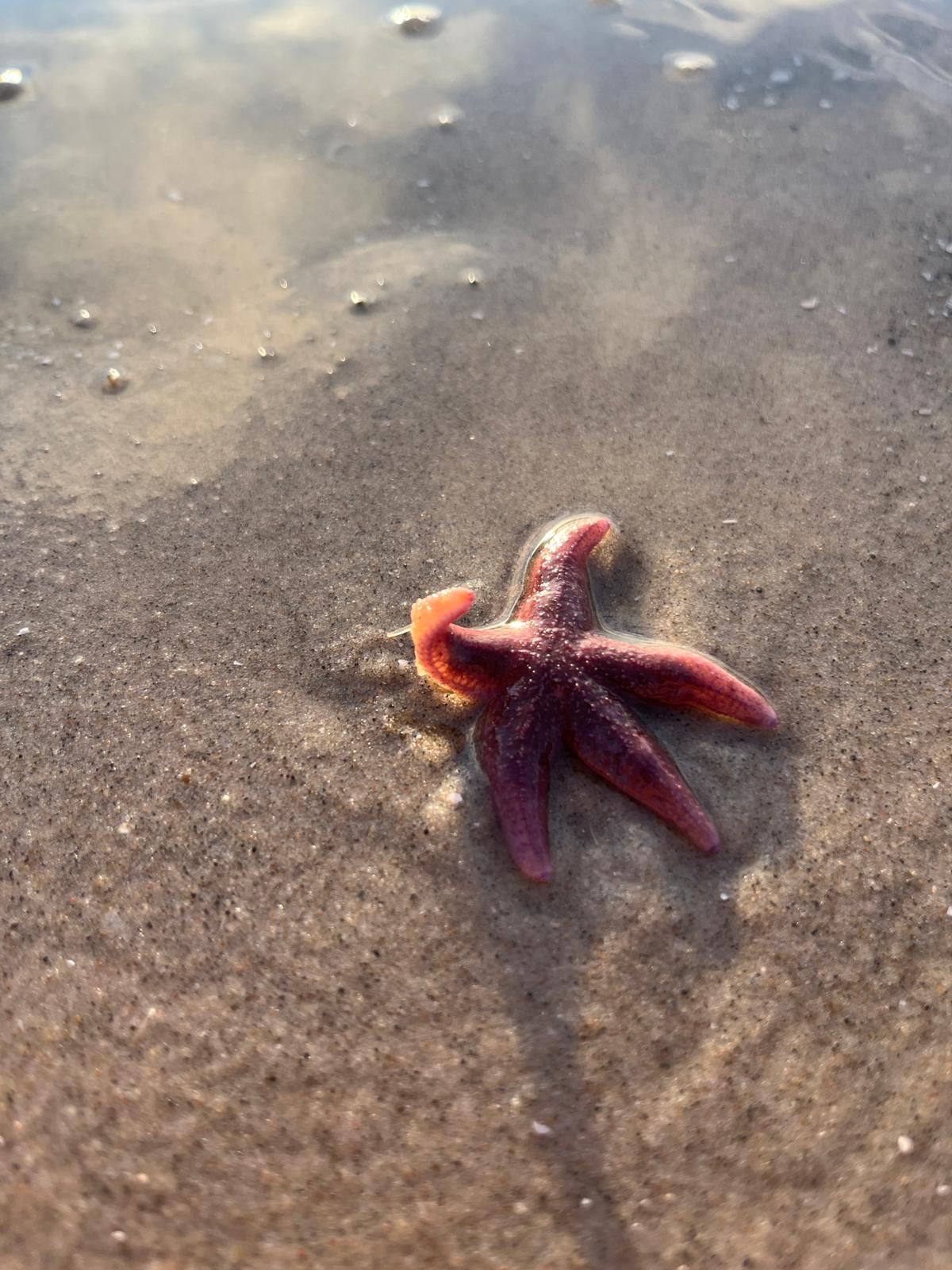 Søstjerne.
Søstjerne.
Resten af eftermiddagen blev brugt på gåture, mens det stadig var lyst. Florian forsøgte at fotografere en bynkefugl (stonechat), der desværre ikke var så samarbejdsvillig, som han kunne have ønsket. Miles så en flok på over 100 rastende sjaggere (fieldfares) og jeg stødte på en spurvehøg (sparrowhawk), fuglekonge (goldcrest) og gærdesmutte (wren) i det efterårskolde hedelandskab.
Se dagens observationer fra Grenen her.
Folk på stationen: Miles Scheuering, János Schadl, Florian Hatt, Amira Nuseibeh, Lise Mastrup
Tæt på land!

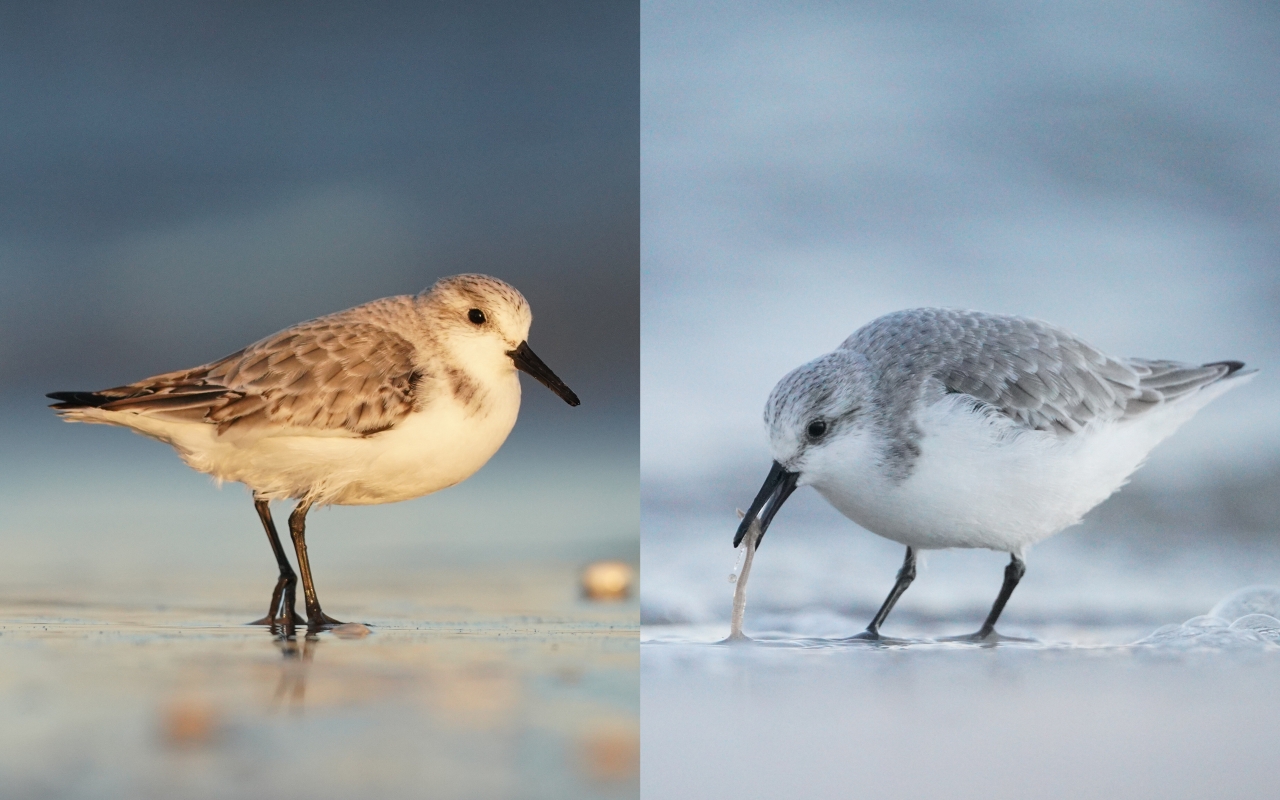
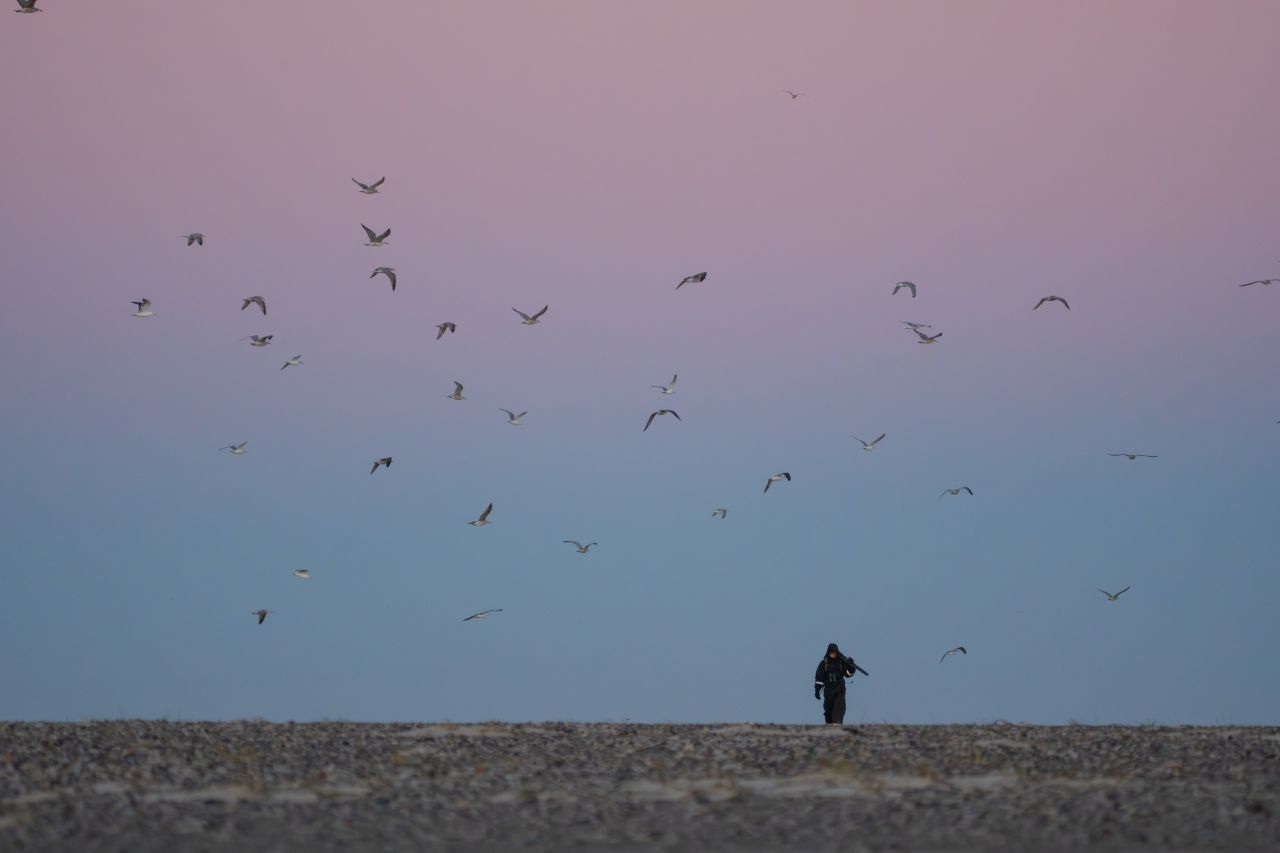
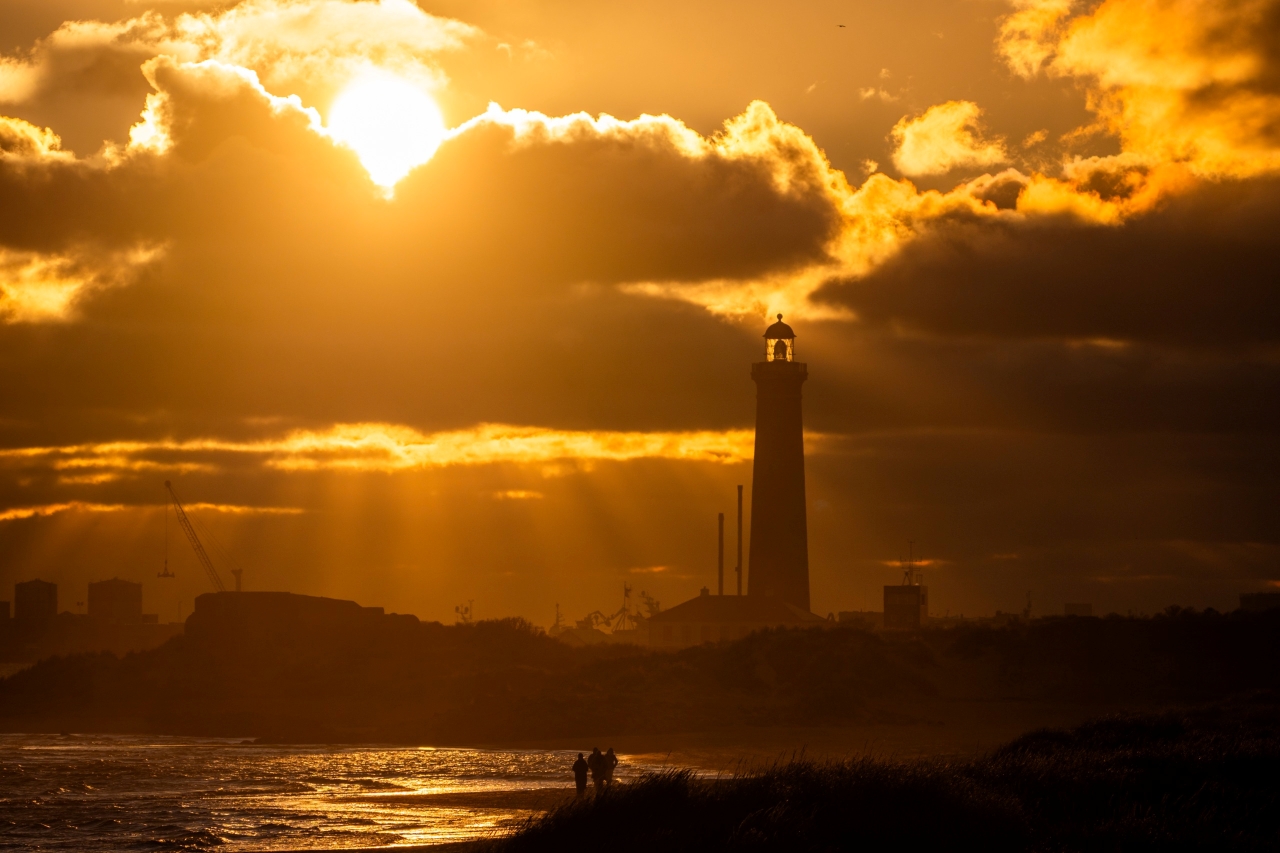
Link to today’s observations from the area.
People: Miles Scheuering, János Schadl, Florian Hatt, Amira Nuseibeh, Lise Mastrup
- and since the ringing season is officially over -
The autumn season at Kabeltromlen
Since starting on 20th July, the autumn’s standard ringing season at Kabeltromlen came to an end on 20th November. In total 4945 new birds were ringed by volunteers and guest ringers who contributed to the observatory’s work. A big thank you to all of these people!
Looking back at the data from the past four months tells us that the most common species ringed was Blue Tit (Cyanistes caeruleus) with a total of 978 individuals. These are followed by 735 Goldcrests (Regulus regulus) and 415 Blackcaps (Sylvia atricapilla). Compared to autumn 2024, about twice as many birds were ringed during the autumn season this year. Take a look at the graphs to see the per day and total amount of ringed birds for the 2024 and 2025 autumn seasons.
Long-tailed Tits (Aegithalos caudatus, 100 ringed), Bullfinches (Pyrrhula pyrrhula, 203 ringed) and Coal Tits (Periparus ater, 165 ringed) were on the move from the north this year giving high numbers of these species in the nets. From the south the Firecrests (Regulus ignicapilla) came with a high total of 8 ringed birds.
The rarest bird was a Dusky Warbler (Phylloscopus fuscatus). Other highlights included Barred Warbler (Curruca nisoria), Ring Ouzel (Turdus torquatus), Blue Throats (Luscinia svecica), Twites (Linaria flavirostris), Siberian Chiffchaffs (Phylloscopus collybita tristis), Wryneck (Jynx torquilla), Great Grey Shrike (Lanius excubitor) and Kingfisher (Alcedo atthis).
The 6th October was a day to the history books when 742 birds were ringed. Never before has so many birds got a ring on at Grenen.
It goes without saying that we are thrilled to look back on great ringing season here in Skagen! For now, ringing gear has been packed away, ready for next year’s spring season to start on 20th March. We hope for another great season and look forward to whichever birds might show up!
Ringing is carried out by ringers with licenses from the Ringing Administration at the Natural History Museum of Denmark.
/
Efterårssæsonen ved Kabeltromlen
Den 20. juli startede denne efterårssæson for ringmærkning og nu er den for nylig afsluttet den 20. november. I alt blev 4945 nye fugle ringmærket af frivillige fra stationen og gæstende ringmærkere. En stor tak skal lyde til alle, som har bidraget til dette arbejde!
Dataen indsamlet de sidste fire måneder fortæller, at den hyppigst ringmærkede art var Blåmejse (Cyanistes caeruleus) med i alt 978 fugle. Disse er efterfulgt af 735 Fuglekonger (Regulus regulus) og 415 Munk (Sylvia atricapilla). Sammenlignet med efteråret 2024 blev omkring dobbelt så mange fugle ringmærket denne efterårssæson. Se graferne for at få et overblik over, hvor mange fugle der blev ringmærket per dag og i alt for efterårssæsonerne 2024 og 2025.
Halemejser (Aegithalos caudatus, 100 ringmærkede), Dompapper (Pyrrhula pyrrhula, 203 ringmærkede) og Sortmejser (Periparus ater, 165 ringmærkede) trak især i år i høje antal fra nord, hvilket afspejlede sig i mængderne af disse arter i nettene. Fra syd kom Rødtoppede Fuglekonger (Regulus ignicapilla), som der i alt blev ringmærket 8 individer af.
Den sjældneste art var Brun Løvsanger (Phylloscopus fuscatus). Andre højdepunkter var blandt andet Høgesanger (Curruca nisoria), Ringdrossel (Turdus torquatus), Blåhals (Luscinia svecica), Bjergirisk (Linaria flavirostris), Sibirisk Gransanger (Phylloscopus collybita tristis), Vendehals (Jynx torquilla), Stor Tornskade (Lanius excubitor) og Isfugl (Alcedo atthis).
Den 6. Oktober blev en historisk dag, hvor 742 fugle blev ringmærkede. Der er hidtil aldrig ringmærket så mange fugle på én dag ved Grenen.
Vi er glade for at kunne se tilbage på en god ringmærkningssæson her i Skagen! Nu er net og andet grej pakket ned, klar til at forårets ringmærkningssæson starter den 20. marts. Vi krydser fingre for endnu en fantastisk sæson og er spændte på hvilke fugle der må dukke op!
Ringmærkning er foretaget af ringmærkere med licens fra Ringmærkningsadministrationen ved Statens Naturhistoriske Museum.
From Windy seas to Woodcock fields
Another windy morning meant that Lise, Florian, János and I headed to Nordstrand for this morning’s migration count. The migration was probably the slowest it’s been since I arrived in Skagen but still it was a very entertaining and pleasant morning in our sheltered seawatching spot. In terms of rarities, the highlight was definitely a nice Great Northern Diver (Islom) which flew in front of us before landing on the sea. We also had a couple of Taiga Bean Geese (Tajgasædgås) flying by and several flocks of Whooper Swans (Sangsvane), which always make us look up and smile. Interestingly, we’ve been noticing the flocks transitioning from being made up of mostly adults to mostly juveniles now.
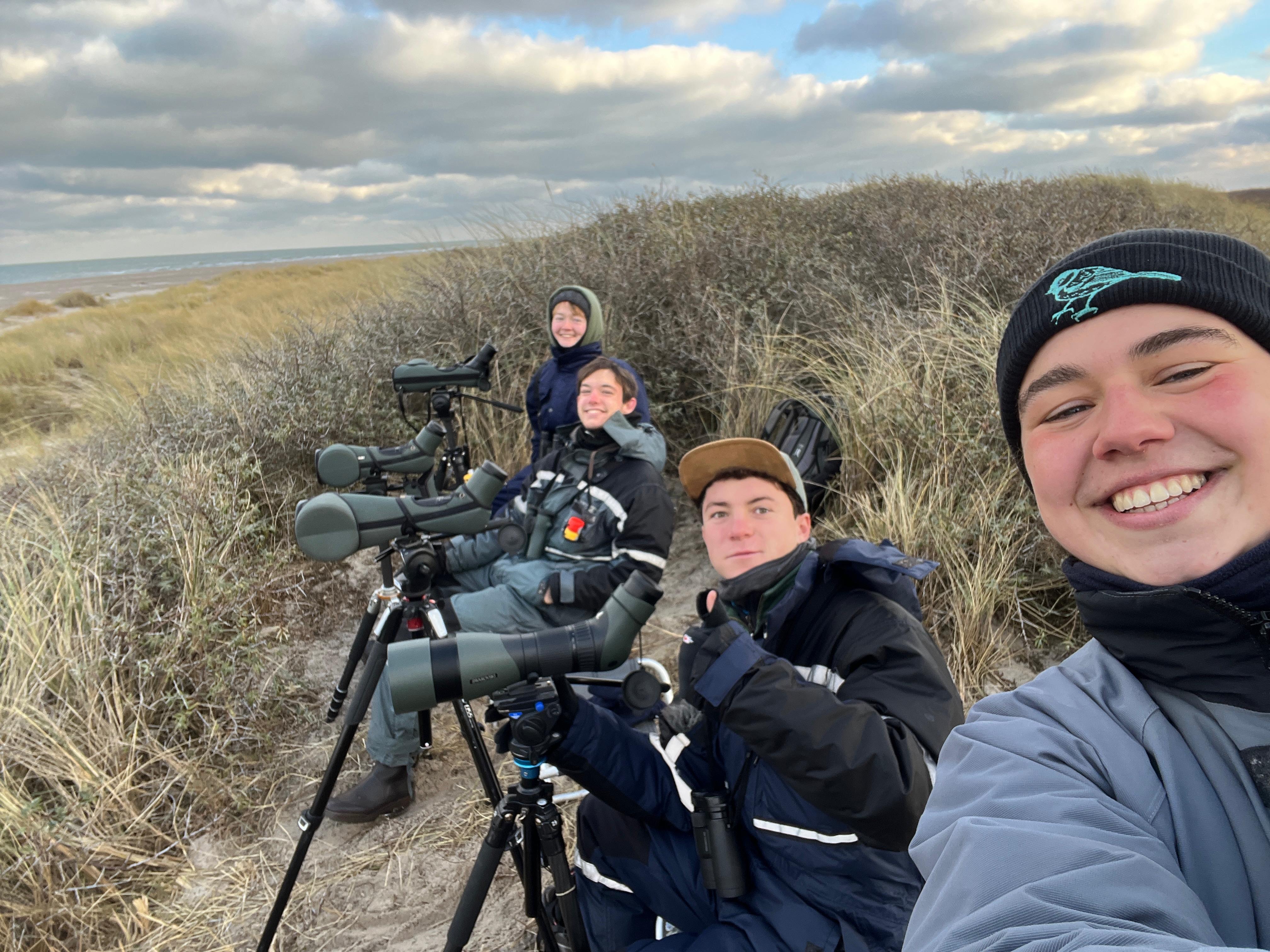
A Great Grey Shrike (Stor Tornskade) was nice to see and a great surprise was a Chiffchaff (Gransanger) which flew up from the bushes behind us and into the grass tufts just in front of our observation spot, and later a Sparrowhawk flew up from close in front of us too! The slow pace of migration meant there was time for practicing identifying Auks (Lomvie/Alk) from a distance which I found challenging with all the “flimmer” (which I’ve learnt means haze in Danish/German) but was still fun nonetheless. 11 dark chocolate rice cakes later, we’d finished the migration count and cycled back home to drop off our warm boiler suits before our afternoon outings.

Florian made a trip to Grenen where he saw his usual two Stonechats (Sortstrubet Bynkefugl), and many Snow Bunting (Snespurv) and Gulls (Måge sp.). He then cycled to the harbour where he joined János for some “gulling”. They tried to entice in the gulls with some sliced bread but unfortunately didn’t spot any rare species this time, but they were lucky enough to see three Turnstone (Stenvender) pottering about which was quite cute.
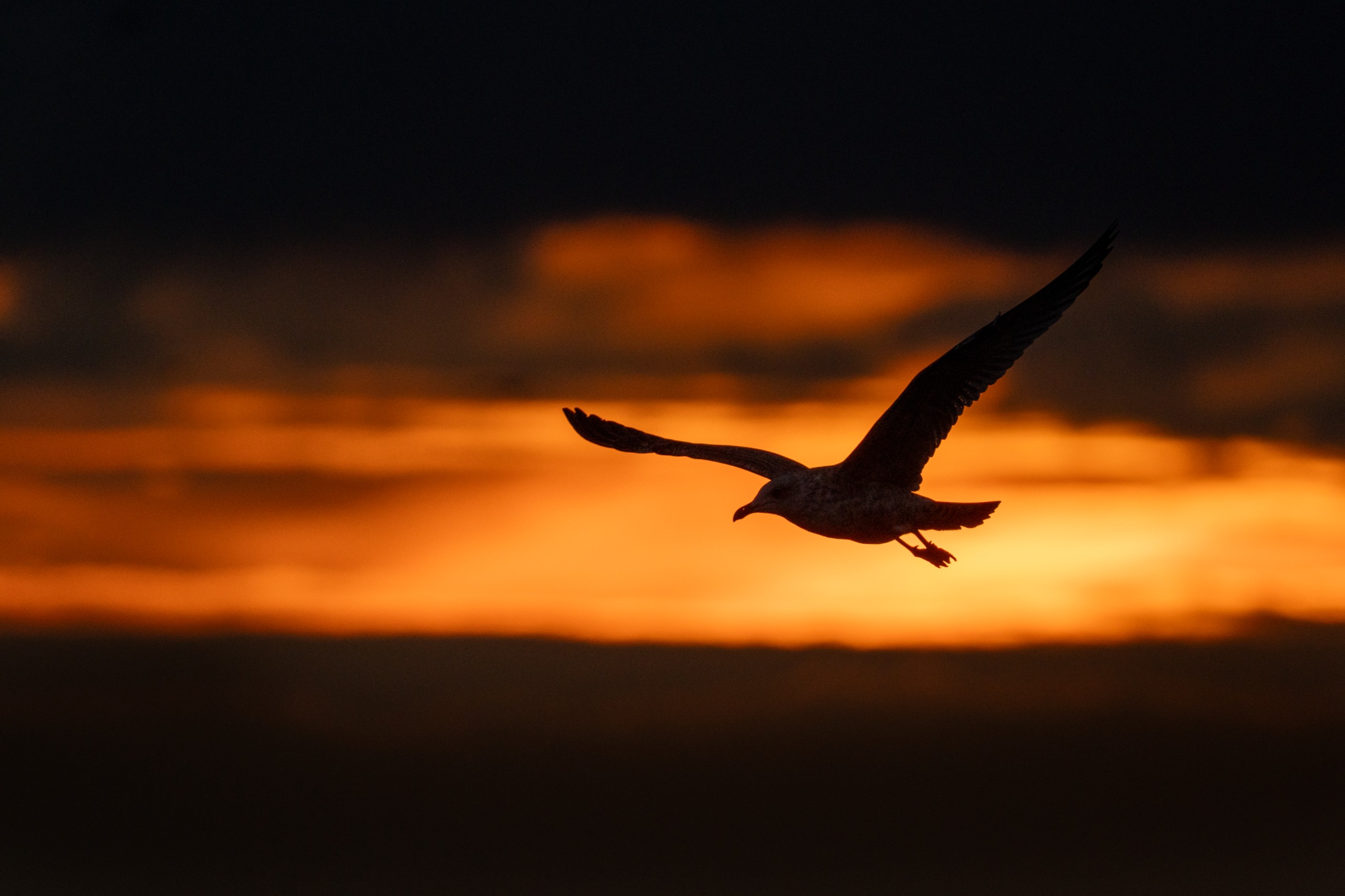
Miles had a quiet morning doing some office tasks, going for a run and battling with sparkly ribbon in an attempt to make some star-shaped decorations for our Christmas tree. In contrast with my disastrous attempts last night, Miles managed to produce two beautiful little shiny green stars which now hang on our tree, alongside a lovely Goose-shaped decoration which was a gift from Mathilde. Then, in the afternoon, he cycled into town (and saw a Woodcock (Skovsneppe) on the way in Batteriskoven) and met Lise for some shopping, including a visit to the charity shop, where Lise found some excellent bargains.
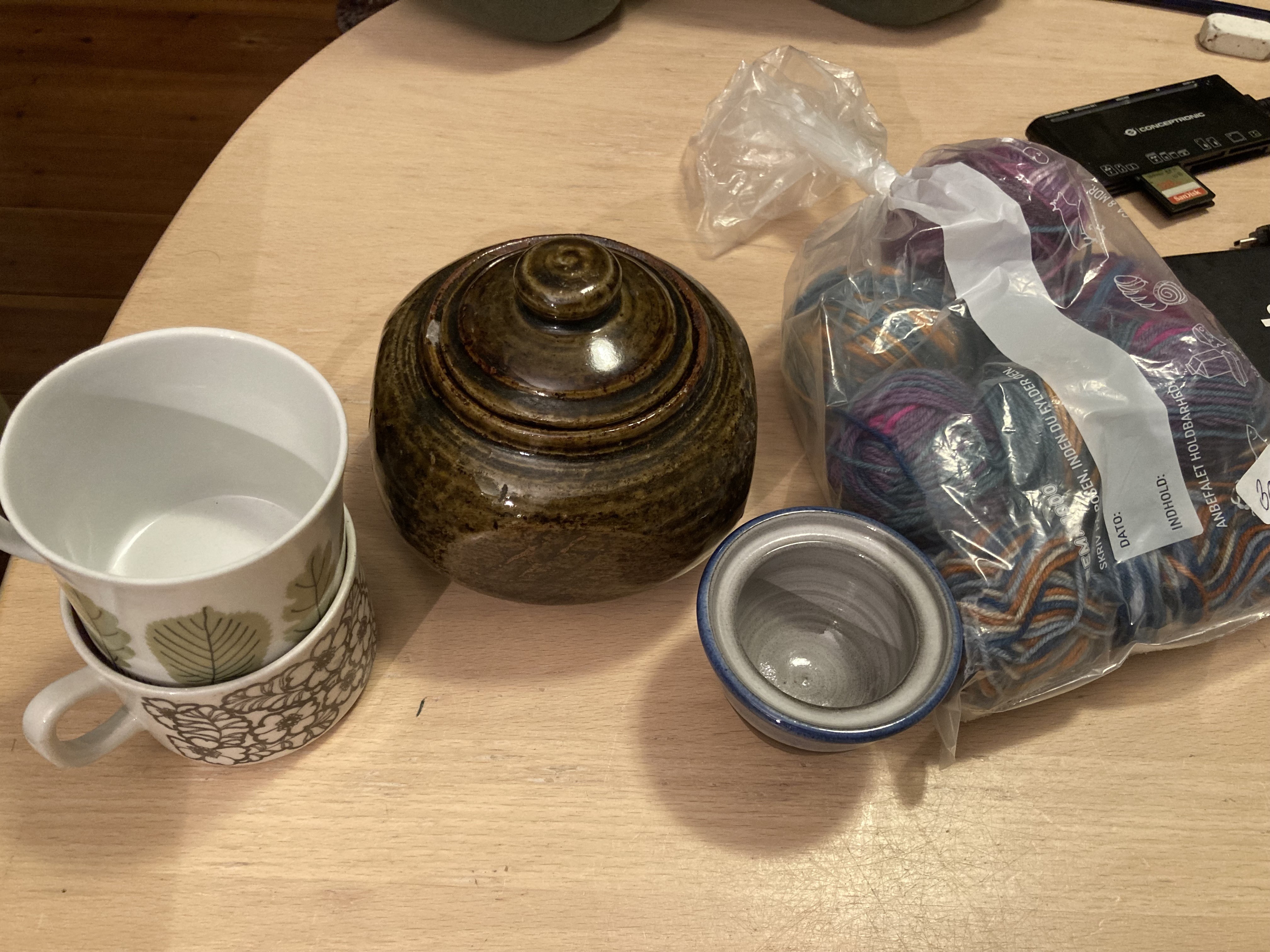
After our evening meeting, János and I wrapped up warm and cycled out to Bankes Marker to try and catch some Woodcock (Skovsneppe). Although we failed once again, it was super cool to see nine Woodcock in only the couple of fields that we checked! They are such funny looking birds and nightcatching is one of the only times we’re able to see them so well, even if we didn’t manage to catch any in the net this time. Now, we’ve just enjoyed a winter-y dinner of spinach, potato and tofu stew cooked by Lise; it was so delicious!

Standard ringing finished
Link to today’s observations from the area.
People: Miles Scheuering, János Schadl, Florian Hatt, Amira Nuseibeh, and Lise Mastrup.
White winged and White billed birds
When we woke up this morning, we first checked the weather forecast, as yesterday it was said that it might rain. But since it looked quite acceptable, there was no sleeping in, but instead everyone went out for the migration count. As the wind was quite strong, we decided to go to Nordstrand, where we could sit in a more sheltered spot than at World's End III. The start was rather uneventful, and there were fewer Kittiwakes (Ride) and Auks (Alkefugle) on the move than in recent days. A few Long-tailed Ducks (Havlit), a Goosander (Stor Skallesluger) and a pair of Red-breasted Mergansers (Toppet Skallesluger) were still great, though. As we had been talking about possible rare gulls over the last few days that might appear here, I kept looking at the gulls that were flying around of course. Suddenly, my attention was caught by a bird circling high above, which showed extremely light-coloured primaries. I zoomed in and when the bird showed its upper wing, I saw what I had been hoping to see. I immediately called out that there was a Glaucous or Iceland Gull (Gråmåge eller Hvidvinget Måge) flying. The somewhat different brown tone in the plumage of this young gull was interesting, as well as the primaries, which faded completely into white without any dark coloration. The bird circled further and further away and was blown north by the wind, making it difficult to find. However, the others were also able to catch a look at it before it disappeared into the distance. Although its shape suggested it was rather an Iceland Gull (Hvidvinget Måge), the observation conditions were too poor for us to be sure about the identification. An aberrant Herring Gull (Sølvemåge) seems very unlikely, but of course cannot be ruled out 100% either. So many of us will have to wait a little longer for this Lifer.
However, excitement was high, and when two Little Auks (Søkonge) flew west shortly afterwards, it was evident that it was once again a good seawatching day. Still in the same hour, I was happy when I saw a diver that was bigger than the Red-throated Divers (Rødstrubet Lom) just before. It was flying directly towards us, so it was looking a bit weird, but I announced it as a Black-throated Diver (Sortstrubet Lom) first. However, when the bird turned to a better angle, I realised: “No, it's a White-billed!” Luckily, the Hvidnæbbet Lom was close enough to get a (poor) record shot. Everyone could see it, so we got in an even better mood. A few funny jokes, sayings and group laughs later, a Great Northern Diver (Islom) showed up, making the day even better!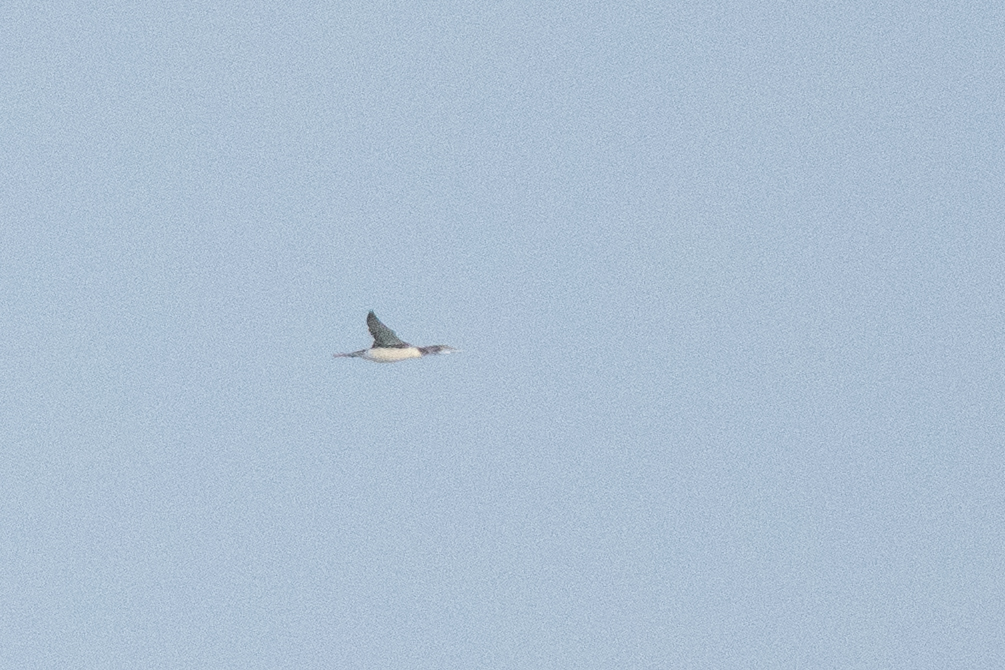
White-billed Diver (Hvidnæbbet Lom). Some yellow pixels in the bill are even visible on this picture
After the count, I stopped several times on the way back and was lucky to see a young Goshawk (Duehøg) at Batteriskoven. When Miles returned from a brief and chilly visit at the industrial area and Amira and Lise came back from their run, it was time for Amira and Miles to go for a swim in the sea once again. The waves were a bit high, so they came back relatively quickly and awaited a warm shower. Janos and I set off to look for gulls at Grenen and in the harbour, hoping to find the bird from this morning again. Sadly, we didn't have much success with the gulls, but we did spot a flock of at least 55 Snow Buntings (Snespurv) on the beach.

"Gulling" at Grenen
And on the way to the harbour, Janos spotted a very dark White Wagtail (Hvid Vipstjert), which could be a good candidate for the British subspecies yarrellii. Amira and Miles also came towards the harbour later, but by then it was already quite dark. On her way back, Amira spotted two Woodcocks (Skovsneppe) on a horse field just as there was still enough daylight to see them. We rounded off this successful day with a tasty dinner made by Janos.
Standard ringing finished
Greath Northern Diver aka Common Loon (Islom) 1
Little Auk aka Dovekie (Søkonge) 2
Iceland or Glaucous Gull (Hvidvinget Måge eller Gråmåge) 1
Link to today’s observations from the area.
People: Miles Scheuering, János Schadl, Florian Hatt, Amira Nuseibeh, Lise Mastrup
Perfect pace of kittiwakes
It was another chilly morning when Amira, János, and Florian headed out for observing, but activity was once again quite good. Yesterday there were many Black-legged Kittiwakes (Ride) and today there were even more! There were many in the first two hours, and even though it could be slightly overwhelming, with over 600 in one hour, Florian still described it as “the perfect pace of kittiwakes.” That pace slowed in the last two hours, but the observers were excited to reach the 2000 mark, so they stayed an extra 30 minutes, even counting down until they all saw the 2000th bird! Auks (Alkefugl) were also numerous. Yet again there were over 2000 Razorbills (Alk) with another 1700 Razorbills/Guillemots (Alk/Lomvie). The observers also spotted a Sooty Shearwater (Sodfarvet Skråpe), and although we have seen many this fall, it is always a pleasure to see one quite close.

János and Florian bundled up in their boiler suits during the mornings migration count at Worlds End 3. Photo by Amira
Lise and I took an “office day” and spent the morning reviewing guidelines, catching up on cataloguing photos in the picture archive, and working on some graphs comparing this autumn’s ringing to last years. Around midmorning we headed out to Kabeltromlen to finish retrieving the rest of the ringing equipment. We brought out an old cart that was sitting in the lab, with the hope it would make carrying things more efficient. I’m not sure it did make things more efficient, but we managed to get everything moved.
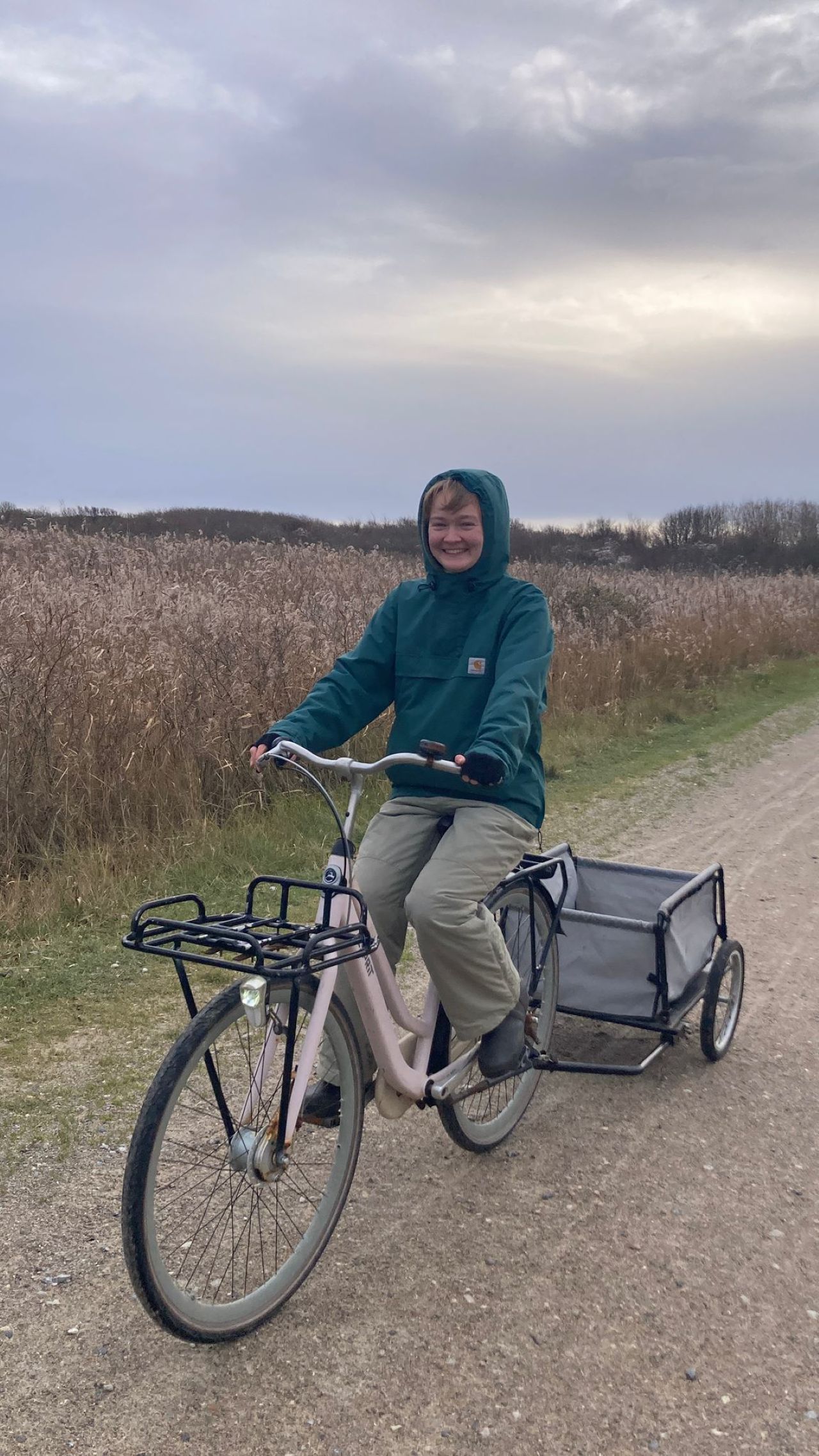
Lise happily transporting the empty cart to Kabeltromlen. The return trip was not documented but I can say that it was significantly slower and less happy. Photo by Amira
In the afternoon we dispersed on various outings. Amira went to the woods at Stald Grenen in search of a Christmas tree for the apartment. It was hard to choose the right one, but I think the one she found is perfect for the apartment! We plan to decorate it tomorrow night, so hopefully we will have a photo for the blog then. Florian went out to Flagbakken for the first time and was impressed by how pretty the landscape was. He did not see so many birds, but Coal Tits (Sortmejse) and Crested Tits (Topmejse) were both nice!
It is a quiet weekend, as Simon is visiting Blavånd Fuglestation. We completed our weekly cleaning this evening, while Lise cooked a delicious zucchini (courgette) soup, with gluten-free rolls and a kale, cabbage, and apple salad. Amira is generally not a fan of apple in salad, but recently she has discovered it can be quite good!
Standard ringing finished
Link to today’s observations from the area.
People: Miles Scheuering, János Schadl, Florian Hatt, Amira Nuseibeh, Lise Mastrup
Ringmærkning lukker og slukker for i år
På Verdens Ende 3 var der i dag rigeligt med fugle for Florian, Miles, János og Knud at tælle. Over 1200 rider (kittiwakes), mere end 2300 alke (razorbills) og dertil to musvåger (common buzzards) og en enkelt søkonge (little auk). Dagens helt store højdepunkt viste sig dog ikke i form af en fugl, men derimod fire spækhuggere (orcas), der lagde vejen forbi Grenen! Umiddelbart var det en flok bestående af to hanner og to mindre individer, enten hunner eller unger. Knud spottede dem ude på havet og herefter kunne de ses et godt stykke tid svømme gennem Skagerrak og genkendes, når man var heldig at se en rygfinne stikke op over havoverfladen eller luft blive pustet ud af deres åndehul. Også fra Kabeltromlen kunne vi følge med i spækhuggerne mellem netrunder.
I går var sidste dag for standard ringmærkning i efterårssæsonen. Som I måske har læst, kunne vi dog ikke ringmærke i går og derfor klarede vi i stedet sæsonens sidste ringmærkning i dag. Amira, Mathilde og jeg cyklede tidligt ud til Kabeltromlen, åbnede net og nød solopgangen. Vi fik sat ringe på blandt andet den fineste lille vindrossel (redwing), nogle vinterklare dompapper (bullfinches) og en enkelt skægmejse (bearded reedling).
Simon kom forbi med lækre snacks og drikkevarer (tak for det!) for at markere slutningen på årets ringmærkning, som observatørerne også kom forbi for at tage del i. Mathilde nåede netop at være med til takke af for nu, inden hun måtte nå toget hjem til København. En rødhals (robin) fik æren af årets allersidste ring, som János gav den på. Måske han også kommer til at mærke næste års allerførste fugl, da han jo heldigvis vender tilbage til Skagen til foråret.
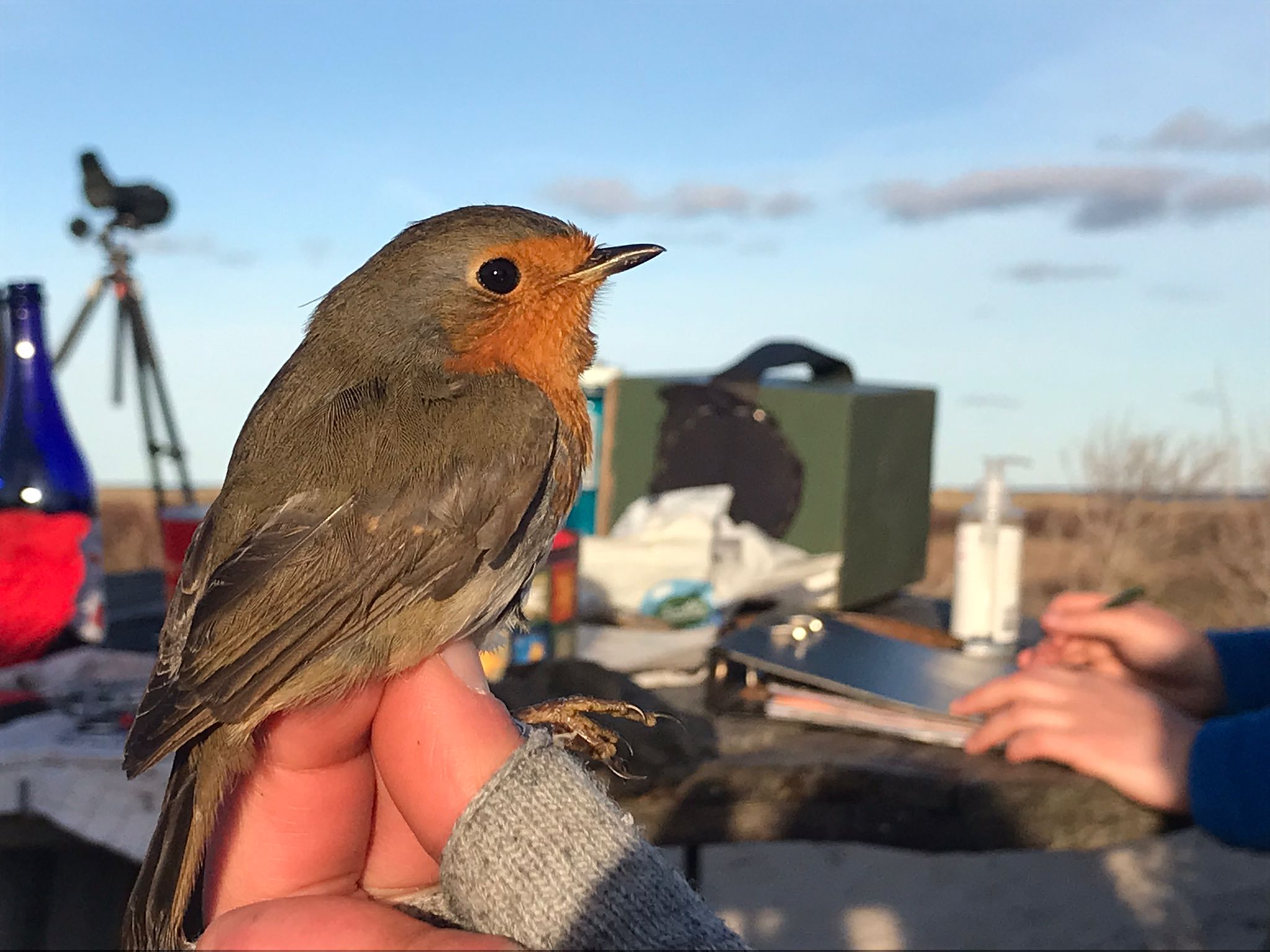 En netop ringmærket rødhals (robin). Måske på gensyn til næste år. I baggrunden ses en flittigt brugt Kabeltromle. Foto af Lise.
En netop ringmærket rødhals (robin). Måske på gensyn til næste år. I baggrunden ses en flittigt brugt Kabeltromle. Foto af Lise.
Efter den sidste mærkning var vi dog langt fra færdige med dagens arbejde. I dejlig eftermiddagssol gik vi i gang med at tage net ned og pakke dem sammen. Heldigt at vi var fem om dette, da det er et større arbejde med at tjekke nettenes tilstand for huller og andet slid, pakke dem ordentligt sammen til forårets frivillige, samt tage alle stænger, snore og pløkker ud af mudderet og bære dem tilbage til stationen. Vi havde derfor fornøjelsen af at få alle dagens solskinstimer med og også nyde solnedgangen fra den gode udsigt ved Kabeltromlen.
 I fuld færd med at pakke en af rundens sidste net sammen. Foto af Amira.
I fuld færd med at pakke en af rundens sidste net sammen. Foto af Amira.
Trætte og tilfredse med dagens arbejde vendte vi hjem til stationen for at taste data ind en sidste gang for dagens aflæsninger og mærkninger. Nu glæder vi os til den aftensmad Florian netop er ved at forberede til os og jeg er ikke i tvivl om vi alle kommer til at sove tungt og godt inden morgendagens opgaver venter os. God aften fra os til alle jer derude!
Folk på stationen: Miles Scheuering, János Schadl, Florian Hatt, Amira Nuseibeh, Lise Mastrup & Mathilde Lundt Larsen
Our Cold but Cozy Nook
Today was a real test for us, battling against the coldest and windiest weather we’ve experienced so far this Autumn. I was excited to be wearing the big cozy boiler suit for the first time for this morning’s migration count and I’m super, super glad I had it! It was too windy for any ringing so all 6 of us, and Knud and his friend, all bundled into the cozy nook at Nordstrand. The counting started off pretty busy with a nice rush of Kittiwakes (Ride), including some first year birds which are rarer to see and quite beautiful, and three Little Auks (Søkonge) too!

However, the volume of migrating birds died down very quickly after the first hour and so we enjoyed celebrating some of the more common species to stay motivated and warm, including some lovely Goosander (Stor Skallesluger), Red-Breasted Merganser (Toppet Skallesluger), and Velvet Scoter (Fløjlsand). I really enjoyed the combination of the slow pace of migration and being sat between Florian and János because there was time for them to teach me about identifying and ageing Common Gulls (Stormmåge) as they flew by, which I appreciated a lot.
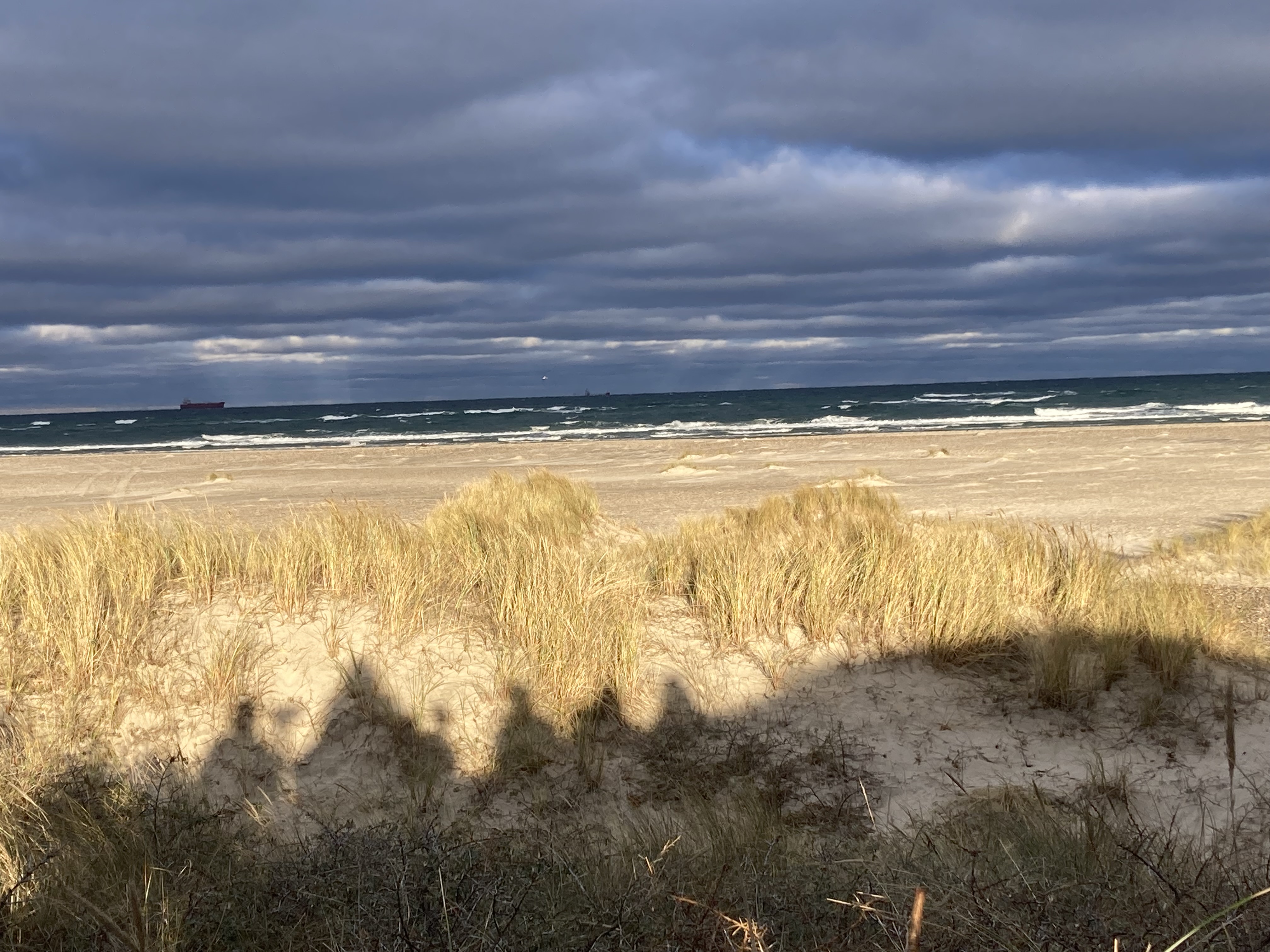
Despite all our layers, our heated socks and lots of running around and gymnastic exercises to keep warm, we were all very excited to be warmed up by the cycle home and enjoyed a lunch all together at the kitchen table. This is an extremely rare occasion, but today we have ended up eating dinner, lunch AND breakfast together which has been very nice.
After lunch, Miles and I headed to Flagbakken, a nice woodland sand dune area on the far side of Skagen town, where the Sunken Church (Tilsandede Kirke) is. It seems the snow yesterday was much heavier there and it’s more sheltered, so the sand and fallen trees were lined with a thin layer of crisp snow; it felt like a winter wonderland! The trees were alive with Goldcrests (Fuglekonge) and Coal Tits (Sortmejse), and Miles even saw an Otter (Odder) running across the path which is very cool.

Meanwhile, Lise and Mathilde visited the centre of Skagen which is very pretty this time of year with all the Christmas trees and decorations everywhere, and they also made a visit to the bakery too. Florian was at the beach at Grenen this afternoon and spotted two of our regular Stonechats (Sortstrubet Bynkefugl) as well as the usual flock of Snow Bunting (Snespurv), which he also put out seed for in the hope that we can maybe catch and ring them in the coming week if we’re lucky!
There was no ringing at Kabeltromlen but today was officially the last day of our standardised ringing season so stay tuned for a full summary of the Autumn season!
Link to today’s observations from the area
People: Miles Scheuering, János Schadl, Florian Hatt, Amira Nuseibeh, Lise Mastrup, Mathilde Lundt Larsen, and Simon S. Christiansen.
